An electric current is a flow of electric charge. In electric circuits this charge is often carried by moving electrons in a wire. It can also be carried by ions in an electrolyte, or by both ions and electrons such as in an ionised gas (plasma)
The SI unit for measuring an electric current is the ampere, which is the flow of electric charge across a surface at the rate of one coulomb per second. Electric current is measured using a device called an ammeter.
Electric currents cause Joule heating, which creates light in incandescent light bulbs. They also create magnetic fields, which are used in motors, inductors and generators.
The moving charged particles in an electric current are called charge carriers. In metals, one or more electrons from each atom are loosely bound to the atom, and can move freely about within the metal. These conduction electrons are the charge carriers in metal conductors.
NOTE: jigssolanki.in does not own this book, neither created nor scanned. We just providing the link already available on internet. If any way it violates the law or has any issues then kindly mail us: jigssolanki1995@gmail.com or Contact Us for this(Link Removal) issue.
1. NCERT BOOK
2. NCERT EXERCISES SOLUTIONS
3. NCERT ADDITIONAL EXERCISES SOLUTIONS
4. NCERT ANSWERS
5. REVISION BOOK
6. REVISION BOOK ANSWERS
7. REVISION NOTE 1
8. REVISION NOTE 2
9. QUICK REVISION
10. REVISION QUESTIONS
11. BEST NOTES OF CURRENT ELECTRICITY
12. CHAPTER NOTE 1
13. FORMULA AND NOTE
14. CHAPTER NOTE 2
15. QUESTIONS ANSWERS NOTE 1
16. CHAPTER NOTE 3
